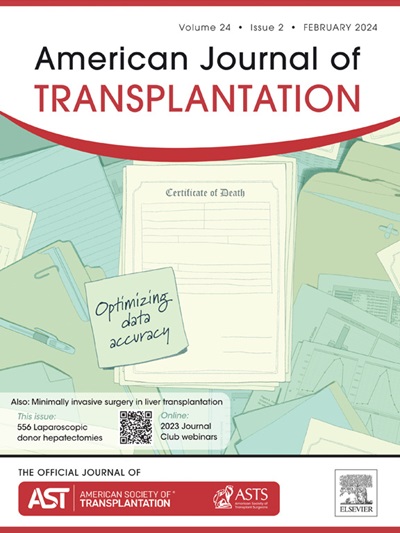Back-table intra-arterial administration of C1 esterase inhibitor to deceased donor kidney allografts improves posttransplant allograft function: Results of a randomized double-blind placebo-controlled clinical trial
IF 8.2
2区 医学
Q1 SURGERY
引用次数: 0
Abstract
Ischemia-reperfusion injury commonly causes delayed graft function (DGF) after kidney transplantation and is associated with poorer graft function and lower allograft survival. Activation of the lectin complement pathway is one mediator of ischemia-reperfusion injury. In this randomized double-blind placebo-controlled pilot study, we tested whether preimplantation intragraft administration of C1 esterase inhibitor (C1INH, a lectin/classical pathway inhibitor) into deceased donor organs improves graft function and/or reduces DGF. Forty patients were randomized 1:1 to receive allografts treated with 500 units C1INH or placebo (normal saline) into the transplant renal artery during back-table preparation. We observed no effect on DGF, but recipients of C1INH-treated allografts showed higher estimated glomerular filtration rate than recipients of placebo at 6 months (C1INH median: 55 mL/min/1.73 m2, interquartile range [IQR]: 42-63; placebo median: 39 mL/min/1.73 m2, IQR: 34-50; P = .02) and 30 months (C1INH median: 54 mL/min/1.73 m2, IQR: 47-66; placebo median: 43 mL/min/1.73 m2, IQR 38-51; P = .03), with no differences in adverse events. Analysis of postreperfusion biopsies showed positive intra-arterial C1INH staining and reduced C4d staining in C1INH-treated grafts compared with controls. Posttransplant serum mannose-binding lectin and classical pathway activity and bradykinin levels did not differ between study arms. We conclude that this treatment strategy improves allograft function independent of DGF, likely via local intragraft complement inhibition.
Clinical trial registration number: NCT04696146.
一项随机双盲安慰剂对照临床试验的结果:动脉内给药C1酯酶抑制剂改善移植后同种异体肾移植的功能。
缺血再灌注损伤(IRI)通常导致肾移植后移植物功能延迟(DGF),并与移植物功能较差和同种异体移植物存活率较低相关。凝集素补体途径的激活是IRI的一种介质。在这项随机双盲安慰剂对照先导研究中,我们测试了植入前将C1酯酶抑制剂(C1INH,一种凝集素/经典途径抑制剂)注入死亡供体器官是否能改善移植物功能和/或降低DGF。40例患者以1:1的比例随机分配,接受500单位C1INH或安慰剂(生理盐水)治疗的同种异体移植,在移植肾动脉中进行背台准备。我们没有观察到对DGF的影响,但在6个月时,接受C1INH治疗的同种异体移植物的eGFR高于安慰剂(C1INH中位数:55 ml/min/1.73 m2, IQR: 42-63;安慰剂中位数:39 ml/min/1.73 m2, IQR 34-50;p=0.02)和30个月(C1INH中位数:54 ml/min/1.73 m2, IQR: 47-66;安慰剂中位数:43 ml/min/1.73 m2, IQR 38-51;P =0.03),不良事件发生率无差异。再灌注后活检分析显示,与对照组相比,经C1INH处理的移植物动脉内C1INH染色呈阳性,C4d染色降低。移植后血清MBL、经典途径活性和缓激素水平在研究组之间没有差异。我们得出结论,这种治疗策略可能通过局部补体抑制来改善同种异体移植物的功能,而不依赖于DGF。临床试验注册号:NCT04696146。
本文章由计算机程序翻译,如有差异,请以英文原文为准。
求助全文
约1分钟内获得全文
求助全文
来源期刊
CiteScore
18.70
自引率
4.50%
发文量
346
审稿时长
26 days
期刊介绍:
The American Journal of Transplantation is a leading journal in the field of transplantation. It serves as a forum for debate and reassessment, an agent of change, and a major platform for promoting understanding, improving results, and advancing science. Published monthly, it provides an essential resource for researchers and clinicians worldwide.
The journal publishes original articles, case reports, invited reviews, letters to the editor, critical reviews, news features, consensus documents, and guidelines over 12 issues a year. It covers all major subject areas in transplantation, including thoracic (heart, lung), abdominal (kidney, liver, pancreas, islets), tissue and stem cell transplantation, organ and tissue donation and preservation, tissue injury, repair, inflammation, and aging, histocompatibility, drugs and pharmacology, graft survival, and prevention of graft dysfunction and failure. It also explores ethical and social issues in the field.

 求助内容:
求助内容: 应助结果提醒方式:
应助结果提醒方式:


